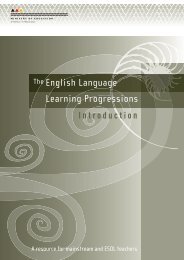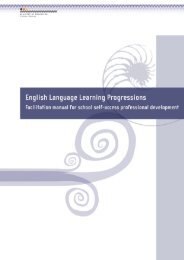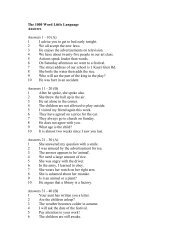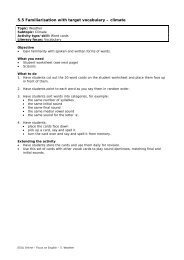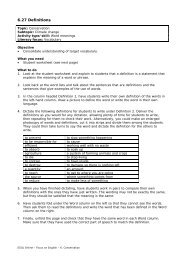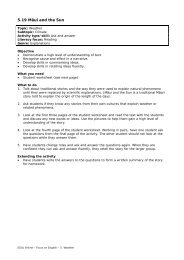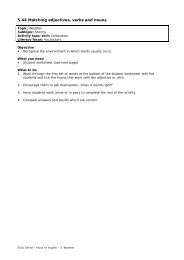ELLP Years1-4 - ESOL - Literacy Online - Te Kete Ipurangi
ELLP Years1-4 - ESOL - Literacy Online - Te Kete Ipurangi
ELLP Years1-4 - ESOL - Literacy Online - Te Kete Ipurangi
You also want an ePaper? Increase the reach of your titles
YUMPU automatically turns print PDFs into web optimized ePapers that Google loves.
The oral language matrix: input<br />
Interpersonal context Content Delivery Language structures First-language support<br />
The learner may understand:<br />
The learner needs:<br />
Foundation Stage<br />
– language use in face-to-face contexts, often<br />
with support from pictures or objects<br />
– limited interactions in pairs (student to<br />
student and student to teacher)<br />
– limited interactions in small-group contexts<br />
– limited interactions in whole-class contexts<br />
– basic concepts expressed in simple English (e.g.,<br />
colours, shapes, time, dates, numbers, body parts,<br />
feelings)<br />
– some basic instructions and simple questions<br />
– models of different types of oral texts (see<br />
Supporting English Language Learning in Primary<br />
Schools)<br />
– slow and clear speech, using simple<br />
language<br />
– direct address, with key words repeated<br />
often<br />
– gestures and facial expressions that<br />
accompany simple instructions, information,<br />
or questions<br />
– individual words and some short chunks of<br />
language (formulaic chunks)<br />
– extensive first-language support (e.g.,<br />
through bilingual helpers or bilingual picture<br />
dictionaries and first-language texts)<br />
– words that are significant to or for them<br />
Stage 1<br />
– limited interactions in pairs (student to<br />
student and student to teacher)<br />
– limited interactions in small-group contexts<br />
– limited interactions in whole-class contexts<br />
– curriculum content that reflects what their peers are<br />
learning in mainstream classes<br />
– simple, repetitive texts, such as songs, rhymes,<br />
poems, and raps<br />
– one or two clusters of ideas in familiar curriculum<br />
and social contexts<br />
– carefully scaffolded texts in unfamiliar curriculum<br />
contexts<br />
– the meaning of gestures, facial expressions,<br />
and changes in volume or tone<br />
– slow and clear speech, using longer phrases<br />
of simple language, with key ideas repeated<br />
– standard New Zealand English, including<br />
slang and idioms that are limited and/or<br />
explained<br />
– simple sentences and longer common<br />
phrases<br />
– short passages of natural speech, such as in<br />
conversations and instructions<br />
– extensive first-language support (e.g.,<br />
through bilingual helpers or bilingual picture<br />
dictionaries and first-language texts)<br />
– simple oral texts, which may be presented on CDs,<br />
CD-ROMs, or DVDs (e.g., the CD Junior Journal 34<br />
and 35 )<br />
Stage 2<br />
– interactions in pairs (student to student and<br />
student to teacher)<br />
– interactions in small-group contexts<br />
– interactions in whole-class contexts<br />
– interactions through extended speech (e.g.,<br />
listening to a debate).<br />
– curriculum content that reflects what their peers are<br />
learning in mainstream classes<br />
– some commonly used colloquial expressions and<br />
some Màori words and phrases<br />
– extended speech in familiar curriculum and social<br />
contexts<br />
– extended speech in unfamiliar contexts with support<br />
– short passages of standard New Zealand<br />
English in a range of accents, spoken at a<br />
natural speed<br />
– extended speech that allows pauses for<br />
them to process what they have heard<br />
– the meaning of non-verbal language features<br />
(body language and prosodic features).<br />
– some complex sentences<br />
– complete and incomplete sentences.<br />
– continued first-language support wherever<br />
possible, from bilingual helpers, bilingual<br />
dictionaries, and first-language texts.<br />
– oral texts, which may be presented on CDs, CD-ROMs,<br />
or DVDs.<br />
12





